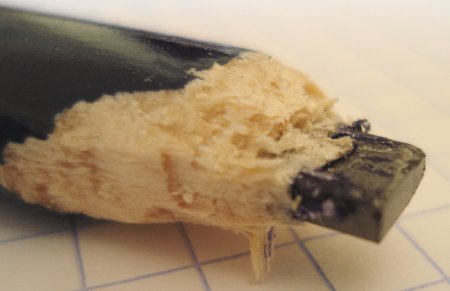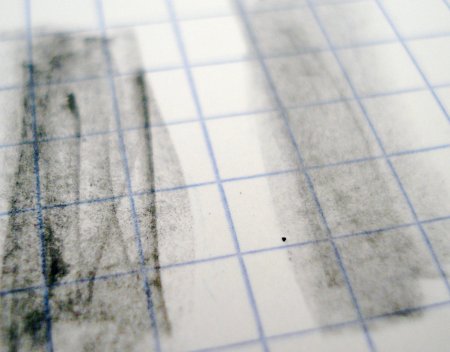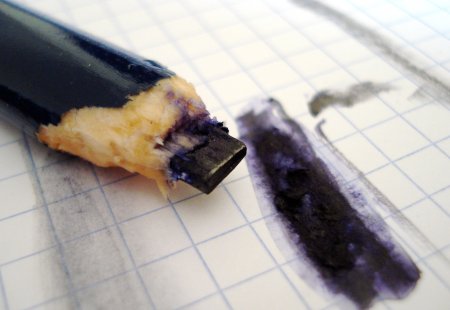
Here is one of the most unusual and specialized pencils ever manufactured.
The Lyra 334 Profi is a nicely finished oval carpenter’s pencil, with silver lettering on dark blue. It is manufactured in the extra long 240mm length. That alone makes it an interesting specialty pencil. Yet this pencil is so unusual that the format barely registers among the special features.

It’s also a copying pencil. That’s right – it has aniline dye added to the lead. Why? My guess would be to support marking on damp and humid wood surfaces.
There are two variants – the 334S is a pure copying pencil, and the 334 is an even more incredible double ended pencil, 2/3 regular lead and 1/3 copying lead.
Finally, this pencil is an additional rarity in being made from White Fir. Though there are mentions here and there of this species being used, the success of cedar, jelutong, and basswood seems to have banished most competitors from the market place. I am glad to have found a rare example of another tree in use.

So how does it work? The first task is sharpening. Unfortunately, it and other Lyra pencils don’t fit the Keson! So out with the penknife. This is where I am guessing that a working carpenter would have a good array of sharp knives and cutters handy – because a pocket knife is losing in the battle to the Fir. Eventually, I got some lead exposed on both ends of the 334.
The lead end marks faintly – perhaps an H grade, and the copying end even fainter. Some water reveals the purple dye of the copying end. It flows less easily than most “writing” copying pencils. Yet – what a hidden treasure it is.

A 240mm oval shaped double-ended carpenter pencil made from White Fir with one third a copying pencil lead. The most extreme specialty pencil?
This is the fourth of a four-part mini-series. Hope you enjoyed it!

Ah, my friend, that sharpening effort is, umm…
Since my family is chock full of carpenters, I would suggest a sharp chisel is the common tool for sharpening a pencil. Far better but less precise than a pen knife.
Indeed, that last picture looks like it was used as a chew toy. Knife sharpening can be tricky if you don’t have a decent knife, or use poor technique. I have to knife-sharpen my 8B pencils since all my sharpeners break the lead too easily, and a friend of mine tried to sharpen a pencil of his with a knife, and I saw him muck it all up not unlike what you did with that carpenter pencil.
What my friend was doing wrong was trying to make too deep a cut at a time, which ended up with him using too much force trying to “chip” the wood away. He also tried to use the edge completely perpendicular to the pencil length, which isn’t an efficient cutting angle and typically causes the cutter to bear down with too much force. Trick for him was to cut at a shallower angle with a lighter touch and with the edge at a modest angle to help slice the wood, rather than chop through. Avoid “scooping” too much as well. If it feels like it’s trying to scoop the wood, you may want to try a shallower angle.
In many shops though, a chisel or a belt sander are easy to use methods of getting a serviceable point quickly. I personally find a knife sharpening method nice and meditative, but it won’t replace my sharpeners for efficiency and speed.
Thanks for the comments. This isn’t how I’d prefer to sharpen such a pencil, but the White Fir really does have different properties than Cedar, and I had to decide to either hack away with the tools at hand and produce something less visually appealing, or not show this highly unusual pencil in use.
Most carpenters ( here in Canada anyway ) use a decent, heavy blade Exacto-type knife all day long and they do an excellent job of keeping carpenters’ pencils sharp.
These photographs are giving me a severe case of pencil pica. Splendid!
I would suggest using sandpaper after cutting away the excess wood with an utility knife.
Searched all the shops in Victoria’s Chinatown and found just one pencil for sale, a Great Wall carpenters pencil # 555, for the magnificent sum of 50 cents. It’s an oval number, red (of course) and has a surprisingly pleasant, smooth lead and seems to compare with an Apsara platinum extra dark. I’ll take it to work tomorrow and try it on just-milled fir.
Where can I buy this pencil over the net? I am in australia.Have u seen the keeson carpenter pencil with red lead?